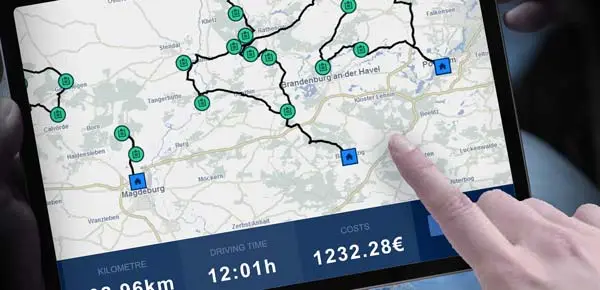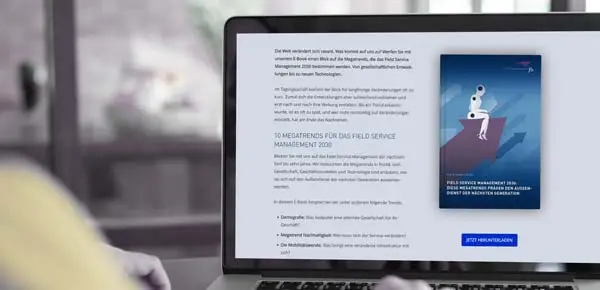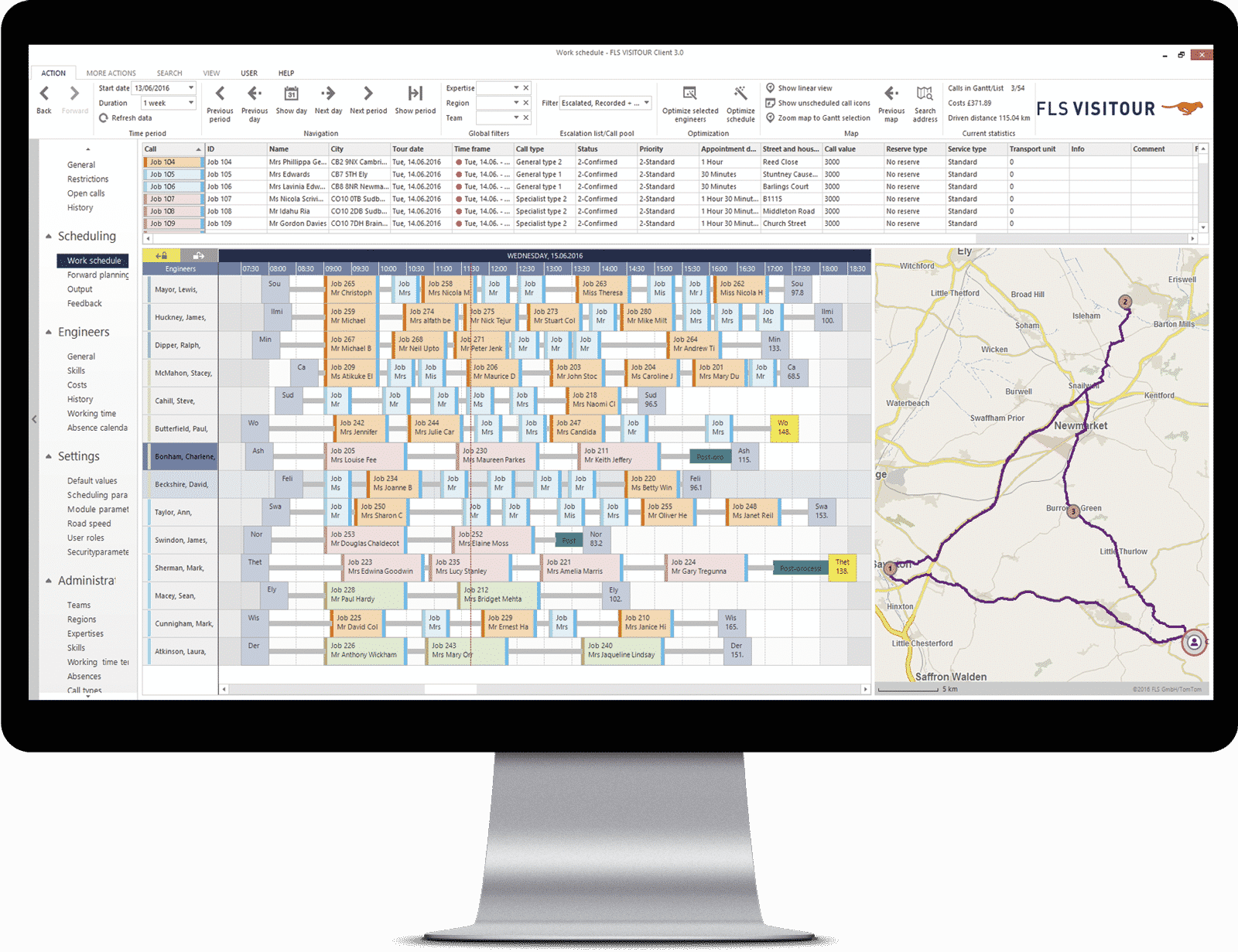
BLOG / SOLUTIONS · FIELD SERVICE TRAVEL TIME
HOW TO PLAN FIELD SERVICES WITH ACCURATE TRAVEL TIME
21 February 2024 · James Alex Waldron
The field service sector continues to navigate economic pressures whilst tasked with improving key performance indicators (KPIs). Across both B2B and B2C service, 'Time to complete order' tells the story of effective resource and workforce management. Enhancing this KPI generally involves pursuing two approaches: Either expanding capacity to handle more work or accomplishing the same tasks with fewer resources. Achieving this requires precision, adaptability, and a comprehensive understanding of the costs and capabilities of field service operatives and equipment.
Planners need digital tools that automate accuracy and provide transparency into costs from the moment a service request is initiated. A dynamic field service planning tool takes into account various factors such as skills (for instance, operatives certified to work at heights), proximity to job sites, and job priority/SLAs when formulating schedules. Its primary objective is to minimise downtime and maximise productivity.
The transition to real-time management adds significant value by enabling immediate responses to spontaneous and unforeseeable situations. Teams can rely on the swift generation of efficient schedules within seconds, recognising that outdated practices like nightly batch runs and manual rescheduling are no longer viable options.
HOW TO IMPROVE 'TIME TO COMPLETE ORDER' WITH TRAVEL TIME
A planning team that schedules appointments without considering realistic time-of-day dependent travel speeds is sacrificing crucial accuracy and missing a significant opportunity for enhanced 'time to complete' outcomes. The conventional route planning from point A to B neglects the ripple effects that a new service request can have on the entire schedule.Optimised routing, calculated for all operatives and appointments, becomes essential amidst congested roads and fluctuating fuel costs. FLS VISITOUR optimises schedules by incorporating precise time-of-day travel speed profiles, seamlessly integrating into job management planning to benefit all stakeholders, including field operatives and customers. This system empowers users to predict travel times accurately and make well-informed decisions.
In contrast to traditional methods relying on road size or static legal speed limits, speed profiles adopt a more nuanced and dynamic approach. Manual route planning often overlooks various obstacles impacting operatives' travel times, such as rush hour congestion, traffic lights, roundabouts, steep slopes, and speed bumps, reflecting realistic driving patterns.
Embedded time-of-day route planning offers substantial cost savings. FLS VISITOUR consistently calculates the fastest route, prioritising efficiency over the shortest distance. This approach eliminates the risks associated with scheduling unnecessary 'white space' into operatives' diaries, minimising idle time, reducing overtime hours, and contributing to an improved work/life balance – all while decreasing fuel consumption and CO2 emissions.
FLS SPEED PROFILES
Route Planning with tools such as Excel, Outlook and Google Maps quickly reaches its limits and offers little flexibility to planners.With FLS VISITOUR, you plan and optimise your orders, routes, and tours within seconds.
Time-of-day dependent: Every individual street is considered for the planning of the daytime dependent speed profiles. Thereby, the best possible degree of reality can be mapped, designing a high level of benefit for 'rush hour' phases versus business hours.
HOW TO USE TRAVEL TIME TO REDUCE ORDER FAILURES
Optimised routing plays a pivotal role to ensuring sustainable 'time to complete' KPI results. A crucial aspect of aligning appointments with both B2B and B2C customer scores involves leveraging precise travel time data to mitigate the risk of first-time failures (missed or unproductive appointments). Failed orders and missing travel time can be directly linked with customer absence, 'no-show' field operatives, and instances of incorrect skills or equipment (when a nearby operative is dispatched as a substitute).Persistent visit first-time failures across any field service - inspection, installation, repairs, or maintenance - leads to a decline in customer scores and complaints contributing to service scheduling complexities, escalating claims, and building the cycle of reactive appointments.
Real-time scheduling with embedded travel speeds serves to mitigate these risks, commencing with a transition to high-quality appointment data. This may encompass asset details, impact assessment, and even the duration from fault identification to report submission. The optimisation process therefore includes accurate time-to-fix and travel estimations.
This approach shifts appointments away from vague 'all day' or simplistic 'AM/PM' appointments, offering the precise windows. This facilitates SMS/email reminders and time-of-arrival notifications, elevating satisfaction levels and reducing threats to job completion, such as unnecessary driving. Customers are empowered to reschedule conveniently, either over the phone or through a portal, with the assurance that only optimised appointments with time-of-day travel considerations are presented.
KEY TO PERFORMANCE: SERVICE PLANNING WITH TRAVEL TIME
Implementing scheduling with travel time safeguards customers from delays, eliminating the need for 'hard' service patches, all while ensuring a fair balance of field operative skills and workloads. This approach, which reduces travel requirements, prevents customers from lengthy, uncompetitive response times.Inefficiencies in routing become more apparent and costly when plans change, a common occurrence in field service due to factors like customer cancellations, emergency assignments, or absences due to illness. In response to in-day events, such as a new reactive service request, FLS VISITOUR dynamically re-optimises the entire workforce schedule and routing in real-time. This involves assessing various value factors for job completion, including availability versus overtime cost. Of utmost importance is evaluating the cost implications of postponing an appointment to the next day or accommodating another request. This strategic process prevents planning teams from falling into the value trap of dispatching the 'closest' operative.
Business benefits with FLS SPEED PROFILES:
- Accurate, through realistic travel time calculations in scheduling and embedded route planning
- Improved customer service: reliable timings prepared within SLA deadline agreement
- Efficiency improvements in head office and field service: Reduced cost, reduction of extra work due to unforeseeable travelling times, and better workload through real-time route optimisation
- Avoidance of congestion and a competitive advantage
YOUR JOURNEY TO OPTIMISED TRAVEL TIME
To gain an understanding of tools to optimise the field experience for your workforce and customers book a short discussion or contact us at info@fastleansmart.com.Discuss fleet options with our telematics partners Webfleet Solutions or Ctrack.
Read more:
Route planning with FLS VISITOUR
Route Scheduling: Outpacing timesheets and Excel
Route planning SaaS: Your competitive advantage
Cost control: Reactive maintenance with Field Service Management software

JAMES ALEX WALDRON
UK Marketing Manager
+44 1183 800189
Send email
James Alex Waldron has worked in written communications for over 15 years. Since 2021, he has written for FLS and the Solvares Group on the topics of digital field service transformation and mobile workforce management, and regularly provides insight to the industry press.






